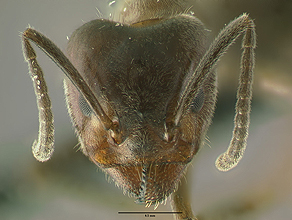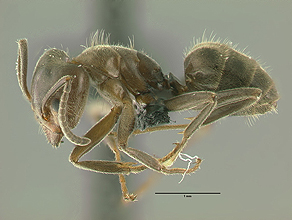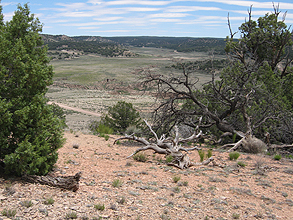- Diagnosis
- Light brown to dark brown workers with an abundance of short erect to appressed hairs. They can be separated from their congener Liometopum luctuosum by a greater density of hairs and a thinner scape.
- Biology
- Distribution
- Species Range
- Neartic; southwestern United States and northwestern to southeastern Mexico.
- Navajo Reservation Field Information
- Liometopum apiculatum is a common ant in the Utah Juniper and Pinon Pine woodlands on Black Mesa. Workers can be identified by the long erect hairs on the pronotum. If disturbed in the field, these ants will emit a strong noxious odor. Workers are polymorphic with the largest individuals approaching the size of small Formica workers.
Occurs in populous colonies, has long and very busy foraging trails and forms nest galleries underneath objects on the ground. Large colonies of up to 85,000 individuals and aggressive workers help make Liometopum apiculatum a dominant species in its favored habitat - oak forests of southwestern North America. Workers are opportunistic and will prey upon other organisms.
Liometopum apiculatum favor dead logs and stones for building the subsurface portions of its polydomous ground nests. They will also build chambers within and underneath human debris.
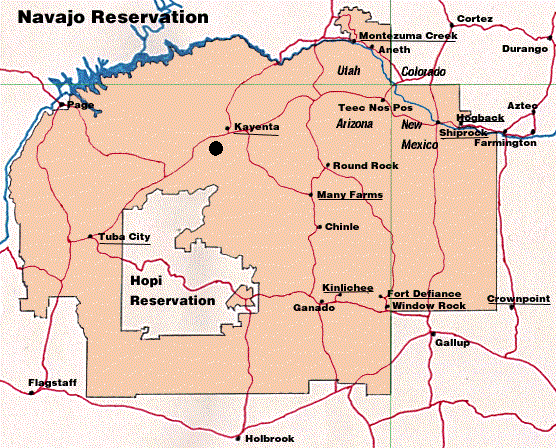
- Additional Notes
- Habitat
- Nests in substrates of various oak forest subhabitat types that are found between 1000 - 2500m. Also reaches into high elevation (~2000 - 2500m) pinyon pine, ponderosa pine and riparian areas. Is also found in creosote bush scrub and grasslands.
- Associations with other species
- Unusual and Noteworthy
- Liometopum apiculatum brood are a Mexican delicacy known as 'escamoles.' This food was once used as tribute presented to Aztec Emperors. Today the demand for brood can be so high that local populations of this ant are reduced by overcollecting. "They are sold in restaurants like El Prendes, Las Meninas, Delmonicos, and Bellinghaussen." A typical meal that serves up escamoles is 2 tacos with ~ 50 grams of ants. "They are served fried or with black butter, but the best way is fried with onions and garlic."
- Description
- Original Combination Mayr (1870)
- Mayr gave a short decsription of the worker. A more thorough treatment, including a treatment of all the forms, was provided by Wheeler (1905):
- Literature
- DeFoliart, G. R. 1992. Insects as human food: Gene DeFoliart discusses some nutritional and economic aspects. Crop Protection. 11:395-399.
- Del Toro, I., J. A. Pacheco, and W. P. Mackay. 2009. Revision of the Ant Genus Liometopum (Hymenoptera: Formicidae). Sociobiology. 53:299-369.
- Emery, C. 1895d. Beiträge zur Kenntniss der nordamerikanischen Ameisenfauna. (Schluss). Zool. Jahrb. Abt. Syst. Geogr. Biol. Tiere 8: 257-360 [queen described]
- Mayr, G. 1870. Neue Formiciden. Verhandlungen der Kaiserlich-Königlichen Zoologisch-Botanischen Gesellschaft in Wien. 20:939-996.
- Mayr, G. 1870b. Neue Formiciden. Verh. K-K. Zool.-Bot. Ges. Wien 20: 939-996 [worker described]
- Miller, T. E. X. 2007. Does having multiple partners weaken the benefits of facultative mutualism? A test with cacti and cactus-tending ants. Oikos. 116:500-512.
- Ramos Elorduy de Conconi, J., J. M. Pino Moreno, C. Marquez Mayaudon, F. Rincon Valdez, M. Alvarado Perez, E. Escamilla Prado, and H. Borgues Rodríguez. 1984. Protein content of some edible insects in Mexico. Journal of Ethnobiology. 4:61-72.
- Ramos Elorduy, J. 2006. Threatened edible insects in Hidalgo, Mexico and some measures to preserve them. Journal of Ethnobiology and Ethnomedicine. 2:51:10 p.
- Shapley, H. 1920. Thermokinetics of Liometopum apiculatum Mayr. Proceedings of the National Academy of Sciences of the United States of America. 6:204-211.
- Shapley, H. 1924. Note on the thermokinetics of dolichoderine ants. Proceedings of the National Academy of Sciences of the United States of America. 10:436-439.
- Shattuck, S. O. 1994. Taxonomic catalog of the ant subfamilies Aneuretinae and Dolichoderinae (Hymenoptera: Formicidae). Univ. Calif. Publ. Entomol. 112:i-xix, 1-241.
- Van Pelt, A. 1971. Trophobiosis and feeding habits of Liometopum apiculatum (Hymenoptera: Formicidae) in the Chisos Mountains, Texas. Annals of the Entomological Society of America. 64:1186.
- Wheeler, G. C.; Wheeler, J. 1951. The ant larvae of the subfamily Dolichoderinae. Proc. Entomol. Soc. Wash. 53: 169-210 [larva described]
- Wheeler, W. M. 1905h. The North American ants of the genus Liometopum. Bull. Am. Mus. Nat. Hist. 21: 321-333 [male described]
This ant has a interesting variety of interactions with other species.
Workers are known to tend membracids and aphids. They will also visits 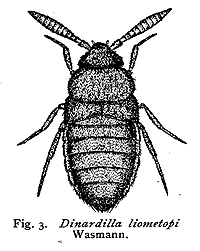 extrafloral nectaries of some Agave, Yucca and Opuntia plants. In the case of Opuntia imbricata, Liometopum apiculatum provides protective services to the plant. Workers are effective at reducing herbivore damage to mature plants.
extrafloral nectaries of some Agave, Yucca and Opuntia plants. In the case of Opuntia imbricata, Liometopum apiculatum provides protective services to the plant. Workers are effective at reducing herbivore damage to mature plants.
Workers will follow the trails of some other ant species. They have also been observed successfully soliciting food from workers of Pogonomyrmex barbatus, Camponotus sayi and Solenopsis xyloni.
Inquilines found living in the nests of Liometopum apiculatum include a cricket and a variety of beetle species. A few of the latter are putatively obligate inquilines that are only known from their nest association with this ant species.
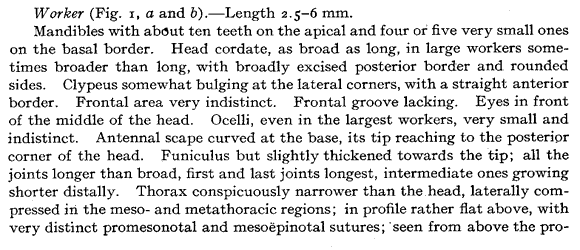
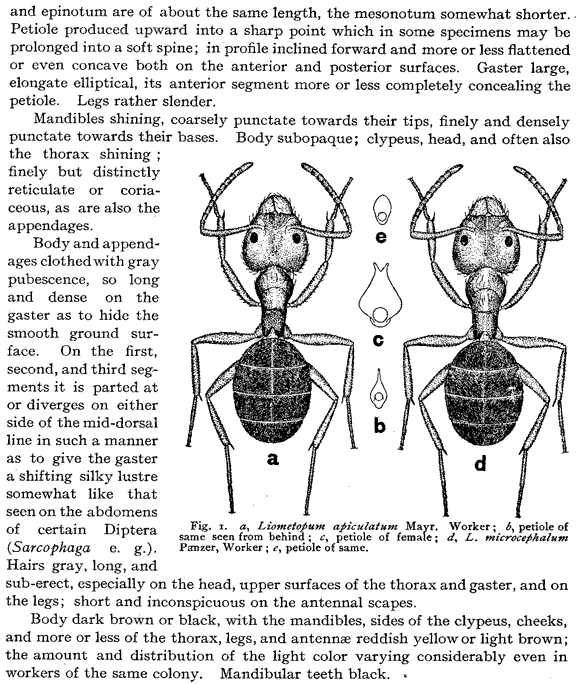
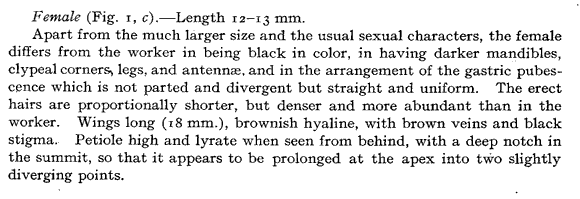
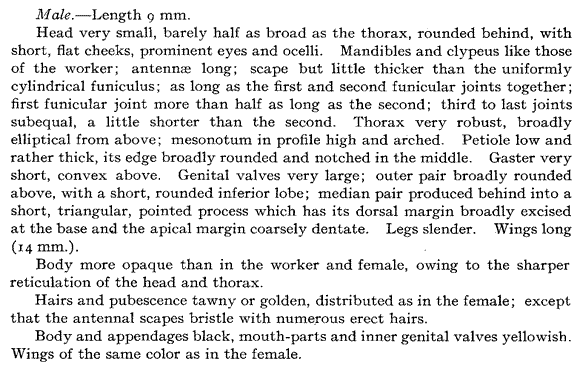
Page authors: Gary Alpert and David Lubertazzi
